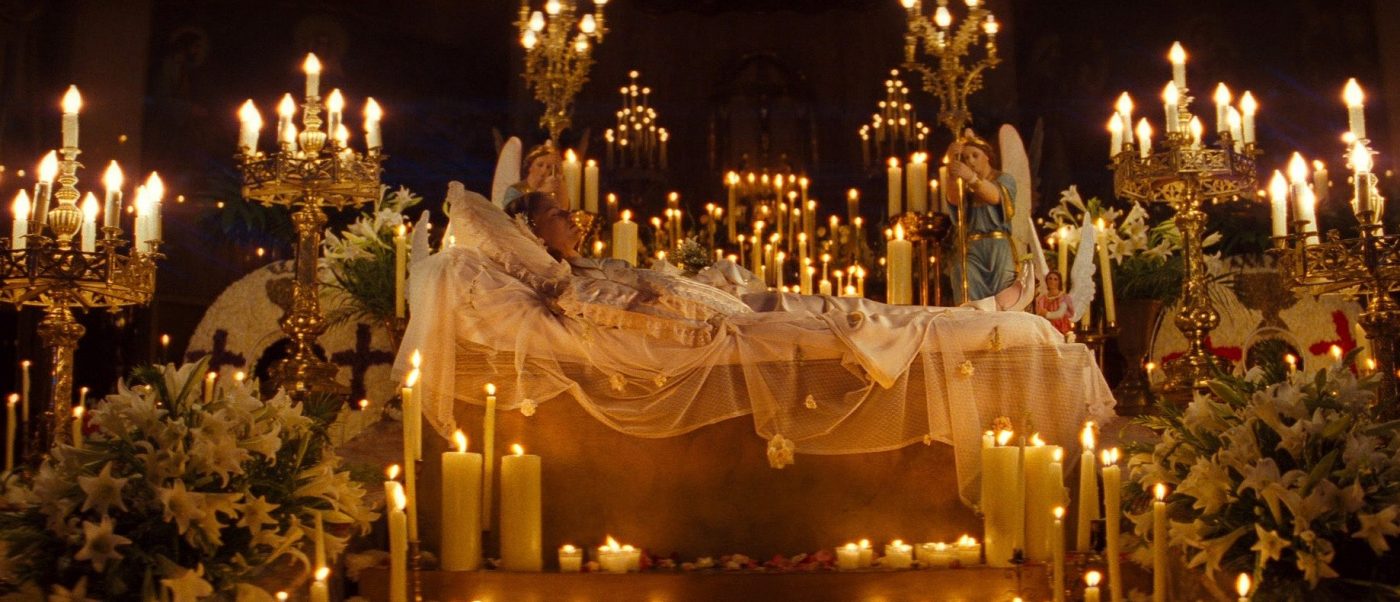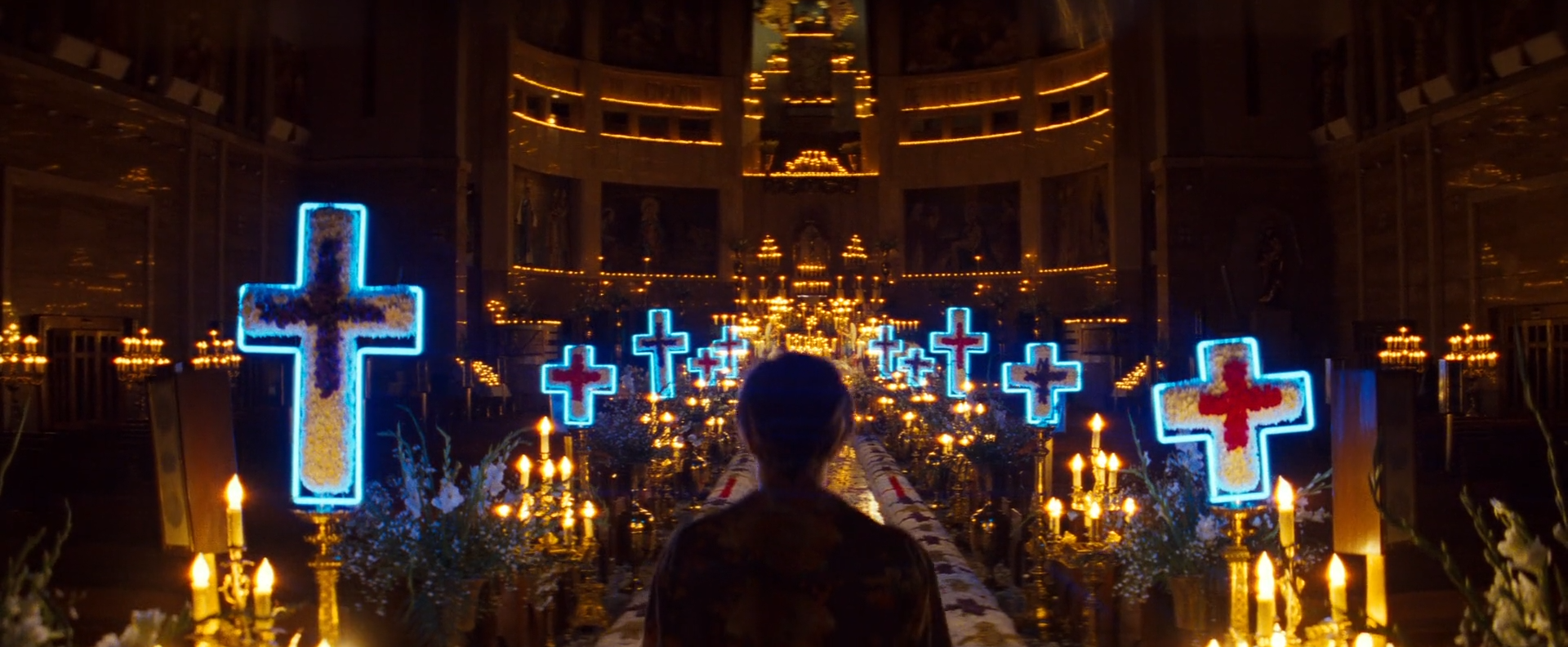
Crucifixes, Glitter and Guns – revisiting Baz Luhrmann’s Romeo + Juliet
Cinematekene er et samarbeid om felles digitale visninger på cinematekene i Bergen, Kristiansand, Lillehammer, Oslo, Stavanger, Tromsø og Trondheim. Montages setter gjennom ukentlige artikler fokus på filmene i utvalget. Baz Luhrmanns Romeo + Juliet (1996) vises fra og med torsdag 18. februar – sjekk tidspunkter i oversikten hos ditt cinematek. (NB: Cinematekene i Oslo og Bergen er stengt, som følge av kommunens smitteverntiltak.)
*
Gabrielė Liepa (b. in 1993) is a film & literature graduate from Amsterdam University College. Gabrielė’s interests include literary and film history, and art films of the Cold War era.
*
Adapting William Shakespeare to screen: if there is an undertaking that would intimidate any filmmaker, this must be the one. First, one must bow down to the deference of the Bard™ and reconcile to stand in his shadow, no matter how many personal auteur touches one has put into the adaptation. Second, the Bard’s esteem is so high that the adaptation will, no matter what, be viewed largely in relation to the source material. Has it been done reverently enough? Has it translated smoothly to the cinematic medium? Have the actors been able to pull it off? There’s enough worry to make one’s head spin and give up the whole idea.
Of course, there have been many iconoclastic and modern adaptations and updates to the plays, both in Theatre and in Cinema. But it is all too easy to dismiss any film adaptation of Shakespeare; after all, cinema is nought but an adolescent cousin to millenia-old Theatre, the much more liberal medium (for one, it is unstrained by the high stakes money brings to a mainstream American film production).
So—can Shakespearean cinema break out of all these constraints without receiving sneers? Just think how even Laurence Olivier’s legendary Hamlet (1948) adaptation was often condemned for shortening the play to half its length. Times, admittedly, have changed, but Baz Luhrmann’s adaptation of Shakespeare’s Romeo and Juliet, for one, remains one of the more divisive cases. To this day it stands as the most financially successful live-action adaptation of any of the Bard’s work. When it came out, it was both lauded and deemed infantile for its often emphasised MTV aesthetic; typical to Luhrmann, his Romeo + Juliet (1996) mashes spectacle, comedy, contemporary music and overall grandiose entertainment with little to no constraint.


This adaptation could not shake off comparisons to one of its cinematic predecessors, Romeo and Juliet (1968) by Franco Zeffirelli, which critics lauded as much more… respectable in every respect. Why couldn’t Luhrmann make something more akin to Zeffirelli’s similarly teen-cast adaptation, the critics pondered? It still seems odd to me that such a wish for a copy of a copy to be made should be expressed – a wish that, unwarranted, seems to be granted all too often in popular [American] cinema these days.
Roger Ebert – the esteemed critic – sneered at Luhrmann’s adaptation and, it seems, its intended audience, suggesting that it would take someone with no prior knowledge about the love and death in Verona to enjoy this film. Well, guess what: not only is it impossible not to know of the fate of these lovers, but by the time an average teen has witnessed the play beaten down to pulp in your average high-school literature class… it’s impossible to care. That should tell you nothing of the play’s merit, for sure, only of the sad fate of great literary works worn down by overuse, and, well, of the sad dynamic between lit classes and puberty-riddled kids. So, the question stands—how do you make Romeo + Juliet feel fresh?
This must have been the quest that Lurmann set for himself, because what he did with his ‘90s take on the play is more daring than any of the preceding film adaptations. The director himself said he wished to make a type of film Shakespeare would have himself, had he the chance to do so. And it’s precisely what Luhrmann achieved: he made a quintessentially cinematic adaptation of the play. And a highly original and fun one at that! I’d even dare say it is the most cinematic retelling of the star-cross’d lovers’ story yet.


First, the setting of Romeo + Juliet is gorgeous, visually rather than verbally showcasing the glaring dualism of opulence and urban poverty, innocence and decay. The location of Verona Beach was chosen as Boca del Rio in Veracruz, where the stunning ruins of the Sycamore Grove theatre make up the main hang out spot for the rivalling clans. This is where the iconic first rendezvous between the viewer and Romeo takes place, a setting that instantly speaks volumes about our hero’s interior, and how much it is at odds with his familial world.
The flashy opening scene of a gas station showdown between the Capulets and Montagues has taken place and Romeo’s parents are chauffeured around looking for him with Romeo’s cousin Benvolio. The car interior, drowning in cold blue, fills up the claustrophobic frame, while a crucifix is accentuated at the center of the shot, and so is a glaring diamond necklace worn by Caroline Montague. Religious symbol kitch is abundant throughout the film, seeming to bless the power of both families, no matter the violence.
Enter the first shot of Romeo, or rather his silhouette, staring into the sea washed with warm, serene sunset hues, cueing a longing that can have only little to do with the symbols of money or power that accompany Montagues. The angsty romantic, with his brooding poetry scribbles and all, is enlivened to a generation of kids who got their ideas about romance by barricading themselves in their bedrooms to listen to sad alternative rock. This gorgeous setting, which Romeo seems to much prefer to his own home (which I’m not sure we ever see in the film, now that I think about it), mirrors his heart’s desire and discontent; this centuries-old character suddenly appears not so different from the teen viewers ogling at him. It is no wonder Leonardo DiCaprio would become the ultimate ‘90s matinee idol – every hormone-filled spirit could watch him and relate to wearing a suit, on a beach, writing poetry.


Romeo seems to be fatally drawn to water (bodies of water are present in most of the film), its unconstrained nature fitting his character—the aquarium sequence of his first encounter with Juliet is enough to melt anyone’s heart, even a cynic’s like mine. And all thanks to the true star of the film, Claire Danes, whose performance radiates irresistible charm and genuine humility. Her as Juliet is, pardon me, as a fish in water, even when she passionately dreams in baroque Shakespearean expressions (what a delightful decision it was to retain the suddenly recontextualised, yet original dialogue).
The playful visual manner of the aquarium scene with its reflections and surface distortions makes the encounter feel surprising, playful and special, in a sort of unpredictable way that first love feels; suddenly, a whole plethora of perceptions is unlocked, and the one way of being – the established way of hatred – appears to be irrelevant.
The lovers’ less than waterproof encounters in the Capulet villa seem to be the only instances in which sentimental scenes are dominated by the colour blue, otherwise reserved for the cold and merciless logic of the world the lovers inhabit (think of the death scene of the lovers: while Romeo strolls up to meet presumably dead Juliet, the path is jarringly lit by both candles and neon crucifixes). For example, on the fateful night when Romeo shoots hateful Tybalt (who, alas, falls into a fountain of water), the rain-drenched scene is epitomised by the shot of an ominous statue of Jesus, coldly-lit and pronouncing judgement upon Romeo’s life.


However, the tragic love story of Verona is only one of the outstanding pillars of this adaptation; the other choice is an abundance of the camp aesthetic, which gives the play a whole new look, feel and, well, wardrobe. And it is fabulous. While Romeo + Juliet is anything but balanced, the fun that it evokes, surprisingly, does not take away from the tragedy of the doomed love. Kym Barrett got famous for her costume work in the film for a good reason: it may be a cold, gloomy lockdown winter in Scandinavia, but Romeo + Juliet will make you wish for a shirt of screaming colours, plus maybe a velvet vest for good measure.
The characters’ wardrobe matches the eccentricity of their moods and actions, and I’m not just talking about the Capulet carnival costumes; it seems that everyone likes their hyper-masculinity sprinkled as much with diva mood swings as with open Hawaiian shirts and hair grease. Mercutio, played by Harold Perrineau, especially shines through; Romeo + Juliet of all film adaptations goes furthest to explore his implied queerness. I’m not only talking of his oddly intense concern over Romeo’s erratic absences and romantic affairs; I’m talking about his extravagant appearance in the Capulet villa, performing Young Hearts Run Free in glittering drag. Or take another scene at the beach, when scantily-clad Mercutio and Benvolio have an odd gun-toting show-off, slightly reminiscent of one in Red River (1948), still memorable for its implicity.


What this romp of muscle and glitter does, ironically enough, is wake the apathetic viewer up out of the weariness of endless images of violence on screen. It allows us to look at this violence and no longer see it as some ancient prerogative of two rivalling clans. The machismo violence is odd and hyperbolic, it no longer makes any sense. The campness not only entertains, though it does so massively; it somehow makes the well-used story feel tragic once again.
Romeo + Juliet is, admittedly, chaotic; but it still manages to engage, entertain and wrench one’s heart. It takes risks (how rare in big productions these days!) and maintains a spirit of youthful rebellion. In fact, Luhrmann’s pizzazz in this film is still uncertain and thus really alive, while in his later films it becomes polished to mere professional decadence.
The reckless energy of Romeo + Juliet is like that of the teens – any teens! – in love. Having grown up with this adaptation, I thought there was no need to revisit it again; I was wrong. After all the lockdown blues, it made me care about such silliness as young love. I thought I could no longer remember, but I did. And perhaps you should, too.